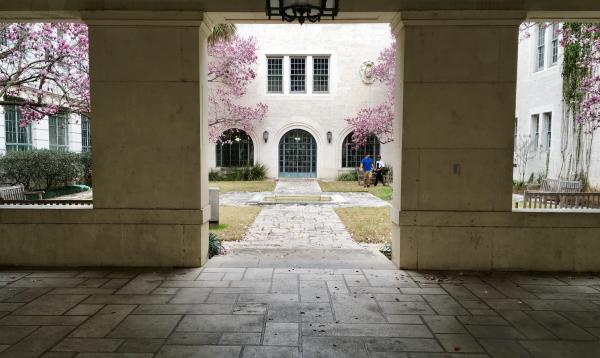Spring 2019 Message from Dean Michelle Addington

February 5, 2019
As we begin the spring semester, I’d like to share with you an update on the School of Architecture’s recent accomplishments and highlight some of the major initiatives that are leading change on campus, in the community, and across the disciplines through a comprehensive program of activities and emerging research.
We recently inaugurated new facilities on the fifth and sixth floors of the West Mall Office building. The research spaces on the sixth floor opened during the fall and serve as the new home for the Center for Sustainable Development and the U.S. D.O.T. Cooperative Mobility for Competitive Megaregions Consortium. And we have just fully opened the new teaching facilities on the fifth floor, where advanced digital technology meets classic review spaces. The renovation and redesign of these floors was a true collaboration between students, staff, and faculty, and we are deeply grateful to the Stillwater Foundation and to the Office of the Executive Vice President and Provost at The University of Texas at Austin for so generously funding this remarkable project. Be on the lookout for upcoming articles and events where we highlight specific aspects of the design and acknowledge all of the individuals who played a role in designing and constructing these extraordinary facilities.
Our collaboration with the City of Austin continues to grow. Significant studies of Austin’s transportation and gentrification issues were completed by our Community and Regional Planning faculty last year, and, in December, the school teamed up with the city to host the East Regional Session of the 2018 Mayor’s Institute on City Design. Mayors of seven other cities joined Austin’s Mayor Steve Adler to discuss challenges facing their constituencies and develop strategies for addressing those challenges. Later this spring, our Center for Sustainable Development will present the results of a comprehensive study of Downtown and the Convention Center to the City Council—insights that will inform city planning decisions.
Latin America has always formed a critical context and provided fundamental content for many of our activities at the school, but this year marks the broadest expansion of activities to date with a robust suite of practicums, field studies, design studios, community collaborations, research initiatives, and university partnerships taking place throughout Latin America. Most of our degree programs, including Community and Regional Planning, Architecture, Landscape Architecture, Urban Design, Historic Preservation, and Architectural History, have a consistent presence in Mexico, and relationships with other countries continue to develop and strengthen. Many of our approaches are now being echoed by the university at large with a campus-wide commitment to global engagement.
“Interdisciplinary” is a common buzzword at universities today, but most have struggled to determine the structure and mechanisms necessary to produce a useful interchange of ideas. The University of Texas at Austin has designed and developed a concerted, committed program, titled “Bridging Barriers,” which brings together faculty from across the university to work together on threegrand challenges. Two of these grand challenges are co-led by our Community and Regional Planning faculty. The first challenge—Planet Texas 2050—intends to address Texas’ resiliency in the face of the pressures and stresses caused by rapid population growth and climate change. Dr. Katherine Lieberknecht has already begun to establish the Texas Metro Observatory—a communication and data platform that will provide the most complete data repository for the state and enable robust data visualization. Dr. Junfeng Jiao, one of the principal investigators of the Good Systems grand challenge that will launch in the fall, will lead a team focused on Smart Cities. This initiative will not only examine how data, social media, and the Internet of Things will impact the social and health aspects of cities, but will also develop a new undergraduate concentration. That our faculty have been asked to provide leadership for these grand challenges is a testament to the disciplinary depth and breadth embedded in our school.
Underpinning all that we do at the School of Architecture is a deep commitment to diversity. It guides who we are, what we teach and research, and how we change our disciplines. Our initiative on Race and Gender in the Built Environment was one of the first at The University of Texas and has already brought an impressive slate of award winning scholars and practitioners to teach and research at the school. In April, the school will open an exhibition honoring John S. Chase, who, in 1950, became the first African American student to attend The University of Texas at Austin School of Architecture and was the first African American architect licensed to practice in Texas. The exhibition was curated by the Houston Public Library, and our students and faculty will introduce additional material. Also in April, we will convene the symposium, Paving the Way: Female Pioneers in Architecture. With invited speakers highlighting the role of women architects in the early- to mid-twentieth century, the symposium will conclude with a roundtable discussion addressing contemporary practice. Our commitment to diversity goes beyond ensuring that there is equitable participation from under-represented populations; it enables us to open up new avenues of discourse and explore unprecedented opportunities as we bring more voices, more experiences, and more knowledge to bear.
In initiatives large and small, short-term and long-term, close to home and far-afield, the School of Architecture is making a difference—in our disciplines, for our students and our communities, and for our future.
D. Michelle Addington
Dean
Henry M. Rockwell Chair in Architecture
School of Architecture
The University of Texas at Austin

